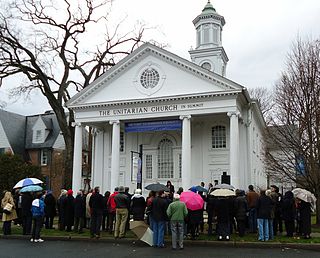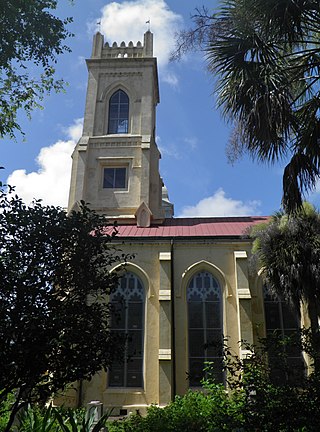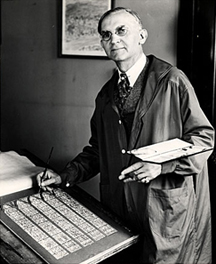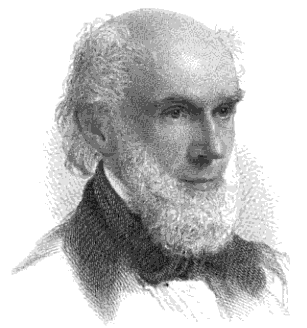
Unity Temple is a Unitarian Universalist church in Oak Park, Illinois, and the home of the Unity Temple Unitarian Universalist Congregation. It was designed by the American architect Frank Lloyd Wright, and built between 1905 and 1908. Unity Temple is considered to be one of Wright's most important structures dating from the first decade of the twentieth century. Because of its consolidation of aesthetic intent and structure through use of a single material, reinforced concrete, Unity Temple is considered by many architects to be the first modern building in the world. This idea became of central importance to the modern architects who followed Wright, such as Ludwig Mies van der Rohe, and even the post-modernists, such as Frank Gehry. In 2019, along with seven other buildings designed by Wright in the 20th century, Unity Temple was added to the UNESCO World Heritage List.

The Universalist Church of West Hartford is a Unitarian Universalist congregation in West Hartford, Connecticut.

Unitarian Universalism, as practiced by the Unitarian Universalist Association (UUA), and the Canadian Unitarian Council (CUC), is a non-Creedal and Liberal theological tradition and an LGBTQ affirming denomination.

The Marble Collegiate Church, founded in 1628, is one of the oldest continuous Protestant congregations in North America. The congregation, which is part of two denominations in the Reformed tradition—the United Church of Christ and the Reformed Church in America—is located at 272 Fifth Avenue at the corner of West 29th Street in the NoMad neighborhood of Manhattan in New York City. It was built in 1851–54 and was designed by Samuel A. Warner in Romanesque Revival style with Gothic trim. The façade is covered in Tuckahoe marble, for which the church, originally called the Fifth Avenue Church, was renamed in 1906.

The Unitarian Church in Charleston, home to a Unitarian Universalist congregation, is an historic church located at 4 Archdale Street in Charleston, South Carolina. It is the oldest Unitarian church in the South and the second oldest church building on the peninsula of Charleston.

Universalist National Memorial Church (UNMC) is a Unitarian Universalist church located at 1810 16th Street, Northwest in the Dupont Circle vicinage of Washington, D.C. Theologically, the church describes itself as "both liberal Christian and Universalist". Originally a member of the Universalist Church of America, it became a member of the Unitarian Universalist Association (UUA) in 1961 when the former merged with the American Unitarian Association to form the UUA, and in 2003, UNMC strengthened its ties to the UUA.

Unitarian Memorial Church is a historic church on 102 Green Street in Fairhaven, Massachusetts, home to the Unitarian Universalist Society of Fairhaven.

First Parish Church in Plymouth is a historic Unitarian Universalist church at the base of Burial Hill on the town square off Leyden Street in Plymouth, Massachusetts. The congregation was founded in 1620 by the Pilgrims in Plymouth. The current building was constructed in 1899.

The Universalist Unitarian Church is a historic church on Silver Street and Elm Street in Waterville, Maine in the United States. Built in 1832 for a Universalist congregation founded in 1826, it is a prominent local example of transitional Federal-Gothic Revival architecture. It was listed on the National Register of Historic Places in 1978.

Charles Jay Connick (1875–1945) was a prominent American painter, muralist, and designer best known for his work in stained glass in the Gothic Revival style. Born in Springboro, Pennsylvania, Connick eventually settled in the Boston area where he opened his studio in 1913. Connick's work is contained in many preeminent churches and chapels, including examples in Boston, Chicago, Detroit, New York City, Pittsburgh, San Francisco, Seattle, and Washington, D.C. He also authored the book Adventures in Light and Color in 1937. Connick's studio continued to operate, and remained a leading producer of stained glass, until 1986.

Ezra Stiles Gannett was a Unitarian minister in Boston, Massachusetts.
Harry Wright Goodhue (1905–1931) was a stained glass artist whose work is featured in churches throughout the United States. During his short career he designed windows for over thirty churches.

First Church in Salem is a Unitarian Universalist church in Salem, Massachusetts that was designed by Solomon Willard and built in 1836. Before the church was built, around 1635, its members had to gather in houses or a building near the Town House Square. The congregation claims to be "one of the oldest continuing Protestant churches in North America and the first to be governed by congregational polity, a central feature of Unitarian Universalism".

Northwest Unitarian Universalist Congregation (Northwest) was organized in 1969. The organization of Northwest was the result of action taken by the Unitarian Universalist Congregation of Atlanta (UUCA) to establish a new congregation in the northwest suburbs of Atlanta.
First Parish in Malden, Universalist is a Unitarian Universalist ("UU") church in Malden, Massachusetts and a member congregation of the Unitarian Universalist Association. It was gathered in 1648 to support the establishment of the city of Malden. It is one of the oldest churches in Massachusetts. The current minister is the Rev. Otto O'Connor, who was called to be the congregation's minister in 2017.

Baker v. Fales, also known as The Dedham Case, was a seminal case of the Massachusetts Supreme Judicial Court. It involved the First Church and Parish in Dedham rejecting the minister the Town of Dedham selected for it and its split into the Allin Congregational Church. It was a major case on the road to the separation of church and state and led to the Commonwealth of Massachusetts formally disestablishing the Congregational Church in 1833.

Theodore Parker Unitarian Universalist Church is a historic church building at 1859 Centre Street in the West Roxbury neighborhood of Boston, Massachusetts. Built in 1900 to a design by West Roxbury native Henry M. Seaver, it is a locally significant example of Normanesque architecture, and is adorned by stained glass windows created by Louis Comfort Tiffany and his firm. The church was listed on the National Register of Historic Places in 2020. The congregation it houses was founded in 1712, and is named for the influential Transcendentalist and abolitionist Theodore Parker, who was the congregation's minister in the 1840s.

The Church of the Unity was a church building designed by H. H. Richardson and built in Springfield, Massachusetts in 1866. It housed the Third Congregational Society, a Unitarian congregation founded in 1819. It was demolished in 1961.
Martin Parry Kennard was a Boston businessman, abolitionist, and U.S. federal government employee.



















